Accelerate Productivity in 2025
Reignite Growth Despite the Global Slowdown
You may also like:
The future technology trends landscape is rapidly changing, and by 2027, global spending on digital transformation is expected to reach USD 3.9 trillion. As enterprises quickly adopt AI, green energy, robotics, quantum computing, and more, investor confidence is at an all-time high.
This guide will enable you to explore the most important future tech trends, as well as their market momentum, business value drivers, and the innovative startups that are leading the way in the next wave of global innovation.
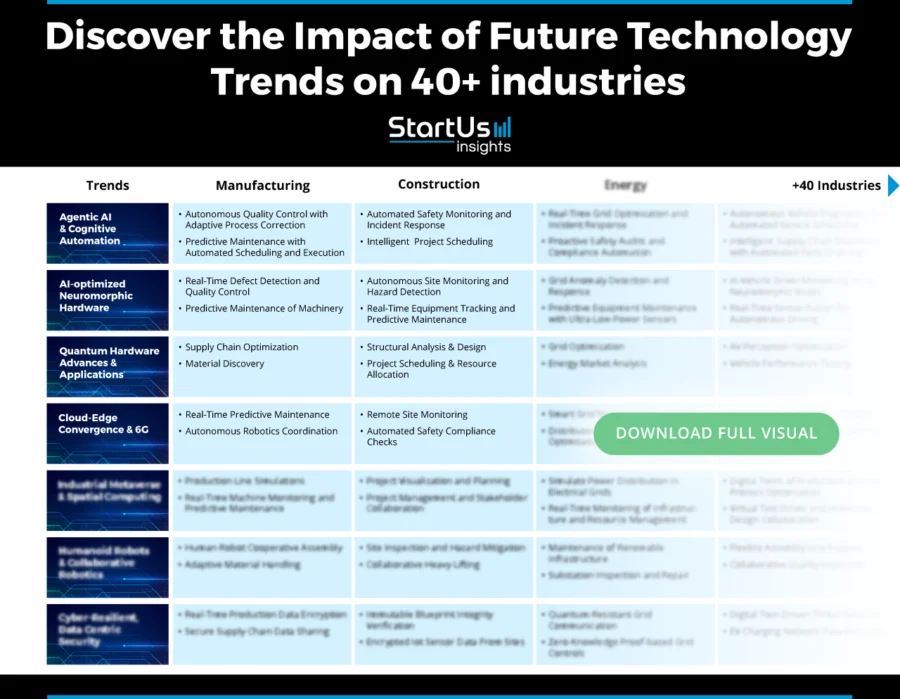
Executive Snapshot
10 Future Technology Trends To Watch in 2025 and Beyond
- Agentic AI Systems and Cognitive Automation
- AI-Optimized Neuromorphic Hardware
- Quantum Hardware Advances & Applications
- Cloud-Edge Convergence & 6G
- Industrial Metaverse & Spatial Computing
- Clean Energy Expansion
- Synthetic Biology
- Humanoid & Collaborative Robots
- Cyber-Resilient Data-Centric Security
- Space-Based Manufacturing & Energy
Top FAQs by Leaders
1. What are the most critical future technology trends to track?
- AI-driven Transformation
- Quantum Computing
- Cybersecurity
2. How to strategically adopt these future technologies?
- Pilot new technologies with controlled experiments before scaling.
- Adopt modular, cloud-native architectures for flexibility and rapid adaptation.
- Invest systematically in talent upskilling across technologies.
3. How to integrate these future technology trends without disrupting existing systems?
- Employ APIs and modular architecture designs for smooth integration.
- Conduct phased rollouts and compatibility assessments through pilot programs.
- Establish dedicated teams for lifecycle management and support during transitions.
10 Future Technology Trends To Watch [2025 – 2030]
1. Agentic AI Systems and Cognitive Automation
Agentic and autonomous AI integrate perception, reasoning, and continuous learning to optimize workflows across various industries.
They autonomously perceive environments, make informed decisions, and refine their actions through ongoing learning loops.
2025 is widely recognized as the “year of the agent,” with Google, OpenAI, and Microsoft launching agentic AI-powered assistants.
Market Momentum
The global agentic AI market is projected to reach USD 47 billion by 2030 at a 44% CAGR. The autonomous AI agents market size is forecast to grow from USD 9.93 billion in 2025 to USD 44.76 billion by 2029 (45.7% CAGR).
Business Value Drivers
Cost Avoidance
Autonomous shipping solutions reduce annual fuel costs. For instance, Orca AI’s alert system saved USD 100 000 fuel per vessel per year. Orca AI achieved a 54% reduction in close encounter events that saved approximately 195 000 tons of CO₂ emissions in 2024.
Also, HR AI agents automate candidate screening and save recruiters 25 hours per week.
New Revenue Streams
Financial AI agents (e.g., Unique) offer productivity gains of 2 hours per employee per week. Startups like Affiniti are deploying AI agents as CFOs to manage financial tasks and aid in strategic financial decisions for small and medium-sized businesses (SMBs).
Risk Reduction
AI agents monitor transactions and ensure compliance with regulatory standards to mitigate the risk of financial penalties and reputational damage. Similarly, in supply chain management, AI agents detect disruptions, assess supplier risks, and provide real-time recommendations to prevent costly delays and inventory shortages.
Breakthroughs & Milestones
Funding Surges
- Adopt AI raised USD 6M for no-code Agentic AI enterprise platforms.
- Orca AI secured USD 72.5M for autonomous maritime navigation.
- Auditoria.AI garnered USD 38M for AI-driven financial automation.
Technological Breakthroughs
- IBM 5-Minute Agent Builder: Enables rapid creation of custom AI agents in less than five minutes on multiple LLM platforms.
- OpenAI Codex Cloud Agent: It specializes in coding tasks and improving software development efficiency.
- CrewAI with Llama 3: Open-source orchestration for collaborative agents that democratize AI teamwork for startups.
- BMW × Figure Humanoids: Deployment of humanoid robots at BMW’s Spartanburg plant for precision metal panel loading tasks, validating industrial-scale applications.
Application Areas
Software Development and DevOps
AI coding assistants like OpenAI Codex Cloud Agent and orchestration frameworks like CrewAI with Llama 3 enable collaborative agent teams to write, review, and deploy code autonomously.
Companies, including Block, integrate these tools to democratize software creation across non-technical teams.
Manufacturing and Industrial Automation
Agentic AI agents are now operating in physical environments.
BMW has partnered with Figure AI to deploy humanoid robot agents at its Spartanburg plant. It automates the loading of complex metal panels.
Spotlighting an Innovator: Synergetics.ai
Synergetics.ai is a US-based company that offers an agent-to-agent communication protocol. It enables autonomous AI agents to securely interact, transact, and collaborate across digital ecosystems.
The platform uses advanced machine learning and automation to enable agents to interpret data, make decisions, and execute tasks with minimal human intervention.
Its AgentWorks suite includes tools like AgentTalk that secure inter-agent communication, AgentWallet for digital asset management, and AgentMarket for deploying AI agents.
Synergetics.ai simplifies the development and deployment of AI solutions with a no-code, drag-and-drop interface.
2. AI-Optimized Neuromorphic Hardware
Inspired by the human brain’s neural architecture, AI-optimized neuromorphic hardware performs complex computation with 100 times less energy consumption.
For example, Intel’s Hala Point features 1.15 billion artificial neurons. It contains more than 10 times more neuron capacity and 12 times higher performance to tackle real-world challenges.
Market Momentum
The neuromorphic computing market is projected to be worth USD 1.32 billion by 2030 with a CAGR of 89.7%.
As per Intel’s report, there’s a rising demand across the consumer, automotive, and defense industries. 55% of technology companies are integrating neuromorphic processors into their AI and machine learning systems.
Around 61% of research institutes explore neuromorphic systems for developing energy-efficient computational models.
The demand is especially high in the autonomous vehicle industry, with 42% of companies using it for real-time data processing. By application, the image processing segment is expected to lead the market.
Business Value Drivers
Energy Efficiency
Neuromorphic chips consume less power than GPUs and CPUs. This makes them deal for edge devices and battery-powered applications. For example, IBM’s TrueNorth chip processes complex AI tasks such as image recognition using a fraction of the energy.
Enhanced Cognitive and Perceptual Abilities
Neuromorphic hardware excels at tasks that involve pattern recognition, sensory data processing, and cognitive functions. This enables more natural human-computer interaction. Qualcomm’s Zeroth processor powers advanced gesture and voice recognition in smartphones.
Radical Energy & Cost Efficiency
Neuromorphic computing is the future of technology as it offloads compute tasks and reduces data center workloads by up to 90%. This directly shrinks electricity and cooling spending. Moreover, these neural processors process sensor data with significantly less energy than digital microcontroller units (MCUs).
Breakthroughs and Innovations
Funding Surges
- Innatera raised EUR 15 million to scale spiking-sensor systems on chips (SoCs) for radar & audio.
- Rain AI raised USD 8.1 million to prep the first analog in-memory SNN chip.
- EU EBRAINS 2.0 expanded Europe’s neuromorphic research infra by raising EUR 38 million.
Technological Breakthroughs
- IBM NorthPole’s On-chip SRAM/in-memory computer eliminates memory shuttling by improving 13 TB/s on-chip bandwidth and 46.9x GPU latency.
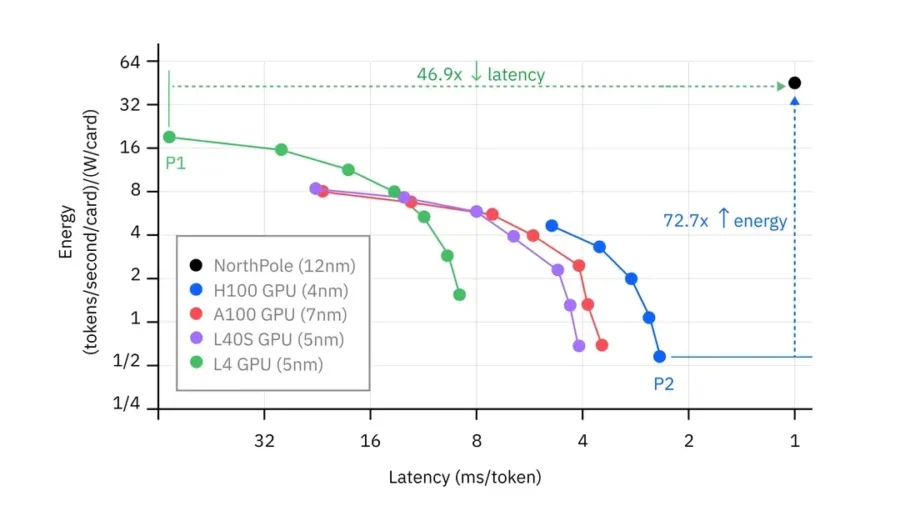
Credit: IBM Research
- Innatera Spiking Neural Processor’s mixed-signal analog SNN cores consume 500x less energy and are 100x faster than MCUs.
- SpiNNaker 2’s asynchronous mesh accelerates distributed graphics processing units to enhance computations for neuromorphic, hybrid, and mainstream AI models.
Application Areas
Edge AI and IoT Devices
Neuromorphic hardware is ideal for edge applications as it enables ultra-low-power, real-time processing. For instance, Intel’s Loihi chip has demonstrated significant power savings in real-time facial expression recognition tasks.
Aerospace and Satellite Communications
Neuromorphic hardware offers efficient on-board data processing capabilities for space applications. Studies have shown that spiking neural networks implemented on neuromorphic chips perform tasks like interference detection and beamforming with lower energy consumption.
Healthcare and Biomedical Devices
Neuromorphic processors are being explored for use in medical devices that require real-time signal processing, like prosthetics and neural interfaces. They mimic neural processing for more natural and responsive interactions between devices and biological systems.
Spotlighting an Innovator: Twistient
Twistient is a US-based startup that develops neuromorphic chips for edge AI applications. It uses a novel transistor architecture to create compute-in-memory systems that emulate the brain’s synaptic behavior at room temperature.
By integrating memory and processing within the same physical layer, these chips eliminate the von Neumann bottleneck and enable real-time, event-driven computation with significantly reduced energy consumption.
Twistient’s technology leverages two-dimensional materials and nanoscale fabrication techniques to achieve scalable, biorealistic architectures capable of adaptive learning.
3. Quantum Hardware Advances & Applications
Quantum hardware is advancing from the laboratory to the real world. Users have experienced error-corrected superconducting, trapped-ion, photonic, topological, annealing, and cat-qubit processors that either break the 100-qubit “utility” barrier or chart clear roadmaps to multi-thousand-qubit machines.
These advances are already powering early commercial pilots in chemistry, finance, logistics, and mobility.
Market Momentum
The global quantum computing market is projected to reach USD 6.8 billion by 2030 with a 30.7 % CAGR.
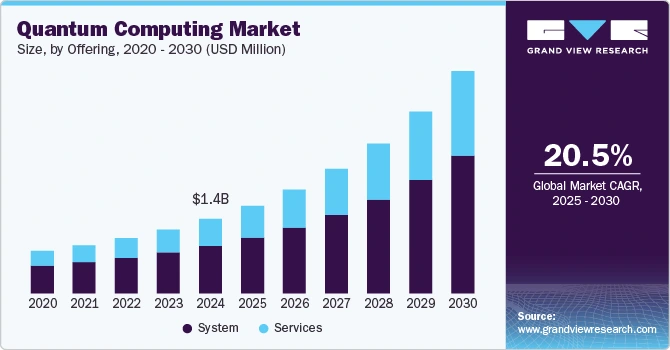
Credit: Grand View Research
McKinsey estimates that quantum technologies could gain up to USD 2 trillion in new value within ten years. To the government capital, Australia committed AUD 940 million to build PsiQuantum’s fault-tolerant photonic computer in Brisbane.
Further, BMW reports multiple in-house proofs of concept and lists quantum optimization as a 2025 production target.
Business Value Drivers
Accelerate R&D and Time-to-Market
Quantum simulators model atomic interactions with far greater fidelity to reduce lead-optimization cycles and de-risk expensive lab work in drug discovery. These processors also let manufacturers iterate new catalysts and solid-state battery chemistries without in-house quantum labs.
Operations and Energy Efficiency
D-Wave’s 4400-qubit Advantage2 prototype solves materials-science lattice problems 25 000 times faster than its predecessor. Neutral-atom machines operate at room temperature and reduce cryogenic OPEX and CO2 footprint compared to superconducting stacks.
Strengthen Cybersecurity and Digital Trust
Quantum-generated entropy and post-quantum-ready key material delivered through cloud APIs provide immediate, differentiable security upgrades for SaaS, IoT, and payments platforms.
Breakthroughs and Innovations
Funding Surges
- PsiQuantum raised USD 620 million to build the world’s first utility-scale photonic QC.
- QuEra, led by Google Quantum AI and SoftBank, raised USD 230 million to commercialize 1000-qubit neutral-atom arrays.
- Quantum Machines targets USD 100 million to control electronics that link heterogeneous quantum chips.
Technological Breakthroughs
- IBM “Flamingo/Kookaburra” modular 1 386-qubit chips networked into 4158 qubits that pave the path to quantum-centric supercomputers.
- Atom Computing’s 1225-qubit neutral-atom processor is the first universal gate-based system beyond 1000 qubits.
- IonQ Forte enterprise achieved AQ 35-36 metric that delivers commercially usable circuit depth for chemistry and ML workloads.
- Microsoft’s Majorana 1, powered by topological qubits, utilizes a novel topoconductor material to enable scalable, fault-tolerant quantum computing.
Application Areas
Life Sciences
Quantum hardware enables the simulation of complex molecular interactions. Its algorithm accelerates the development of treatments for neurodegenerative disease.
Roche‘s partnership with Pasqal utilizes neutral atom quantum processors to model complex protein-ligand interactions more accurately.
Mobility & Manufacturing
Quantum computing optimizes manufacturing processes in supply chains. Its solutions reduce CO2 emissions in supply chains by replacing them with electricity from renewable energy.
Airbus and BMW’s 2024 challenge winners used quantum solvers to trim supply-chain CO₂ and paint-shop cycle times.
Finance
Quantum algorithms are being explored to enhance complex calculations such as options pricing. For instance, Goldman Sachs and Quantum Motion are prototyping option-pricing algorithms that promise real-time risk recalibration.
Logistics
The USDOT 2024 workshop cites quantum-optimized routing for EV-charger placement and freight scheduling. Also, quantum algorithms are being developed to optimize the placement of EV charging stations by considering factors like driving range and demand flow to support the growing adoption of electric vehicles.
Spotlighting an Innovator: Diraq
Diraq, an Australian company, develops silicon-based quantum computing technology that integrates billions of qubits onto a single chip using standard CMOS fabrication processes.
The company employs modified MOSFET transistors, scaled down to control individual electron or hole spins within quantum dots, to enable quantum logic operations.
The company achieves high-fidelity control, with single-qubit gate operations reaching two-qubit gate fidelities. By leveraging the compactness and energy efficiency of silicon spin qubits, Diraq delivers scalable, fault-tolerant quantum processors for commercial applications.
4. Cloud Edge Convergence & 6G
The combination of cloud and edge computing enables businesses to distribute workloads while leveraging real-time analytics, low latency, and better privacy.. This means putting computing closer to users and devices while keeping the cloud’s scalability.
This technology is the foundation for 6G, which is expected to have data rates of terabits per second, latency of less than a millisecond, and built-in support for AI-driven network orchestration.
The AI edge computing market size is projected to reach USD 59 million by 2030 with a CAGR of 21.2%. The 6G solutions market is projected to hit USD 5.23 billion by 2031 with a 32% CAGR.
Market Momentum
According to ABI Research, North America and Asia-Pacific are leading early investments, with China accounting for over 40% of global 6G patent filings and the US Department of Defense toward next-gen wireless research.
Meanwhile, Europe is advancing through programs like Hexa-X, targeting 6G trials by 2028. Together, cloud-edge convergence and 6G are expected to support immersive experiences, autonomous systems, and ultra-reliable industrial automation.
Business Value Drivers
Cost and Energy Optimization
Processing data locally reduces backhaul traffic, lowers bandwidth usage, and lowers power consumption. Firms report direct OPEX reductions that drive sustainable IT operations and lower total cost of ownership (TCO).
Millisecond-Level Latency for Critical Operations
Deploying computers inside 5G cells, like AWS Wavelength, eliminates 100+ ms internet hops. This unlocks real-time applications like robotic automation, remote surgery, and vehicle-to-everything (V2X) safety that centralized cloud models cannot support.
Real-Time AI & Immersive Interactions
Edge nodes reduce latency by up to 50% and run local AI inference that supports predictive maintenance, AR-based service manuals, and more.
Breakthroughs and Innovations
Funding Surges
- South Korea’s Ministry of Science and ICT invested USD 481.7 billion in R&D on core 6G technologies.
- The Smart Networks and Services Joint Undertaking (SNS JU) receives EUR 130 million in EU funding to build first-class 6G technology capacities across Europe.
Technological Breakthroughs
- Future 6G networks will leverage sub-THz and THz frequencies for holographic communication, wireless backhaul, and high-precision sensing.
- 6G will embed AI-native network architectures to enable self-optimizing, predictive, and adaptive systems. Nvidia collaborates with telecom giants on AI-radio access networks (RAN) to boost spectral efficiency and enable real-time network slicing.
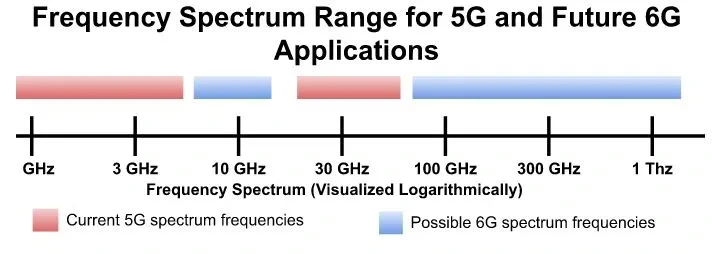
Credit: Cadence
Application Areas
Telemedicine & Remote Monitoring
Nokia’s sub-THz sensing networks are investing in key components of 6G networks, such as joint communications and sensing (JCAS), to allow systems to sense their surroundings. This will enable no-contact heart-rate monitoring.
Autonomous Mobility
Ultra-reliable, high-bandwidth links coordinate fleets of self-driving cars, trucks, and drones. IIT-Hyderabad and Japan’s SSIC developed 6 G/B5 G SDRs supporting V2X navigation at Mobile World Congress 2025.
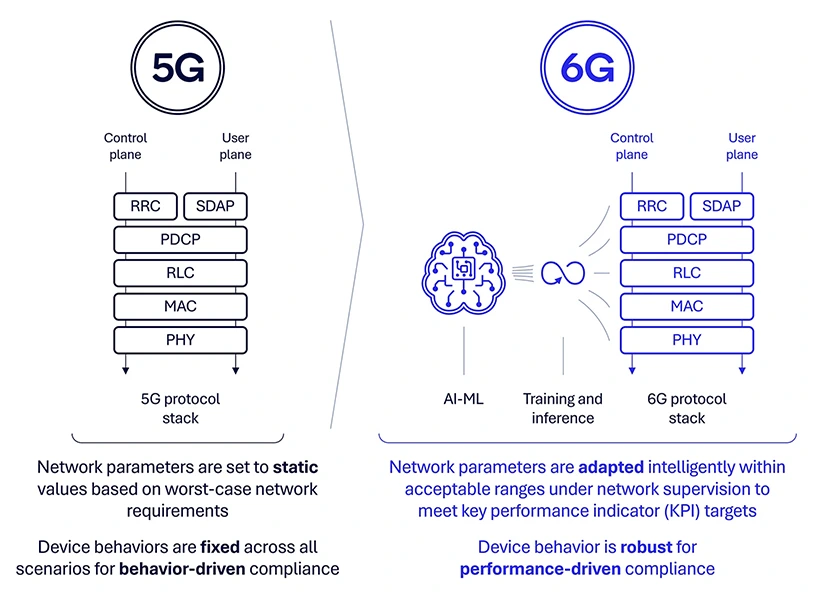
Credit: Qualcomm
Immersive Extended Reality (XR)
Real-time volumetric calls stream a caller’s face and torso as a life-size hologram for enterprise collaboration, tele-learning, and customer service.
Telefónica, Ericsson, and MATSUKO integrated a holographic dialer into Samsung Galaxy phones in the EU-funded 6G-XR project.
Spotlighting an Innovator: Celtonn
Celtonn is an Irish startup that develops high-frequency millimeter-wave semiconductors and systems. It enables ultra-fast 6G data transmission across W-band (75–110 GHz) and D-band (110–170 GHz) spectrums.
The startup’s technology utilizes proprietary amplifier modules and broadband components like power amplifiers, low-noise amplifiers, upconverters, and downconverters to deliver high gain, low noise, and precise frequency control.
Celtonn’s advanced mmWave solutions address the growing demand for high-bandwidth, low-latency connectivity.
5. Industrial Metaverse & Spatial Computing
Advances in simulation engines, spatial computing hardware, and edge-cloud connectivity support the industrial metaverse.
The market value of the industrial metaverse is projected to grow with a 37% CAGR to 2030. Enterprises are leveraging photorealistic digital twins to plan, simulate, and optimize operations in real time. It improves efficiency, reduces emissions, and shortens time-to-market.
Spatial computing further enables these environments to function as fully interactive, AI-integrated workspaces that transform how industrial systems are designed, monitored, and scaled.
Market Momentum
The global industrial metaverse market size is projected to reach USD 183.7 billion by 2032 with a CAGR of 30.1%.
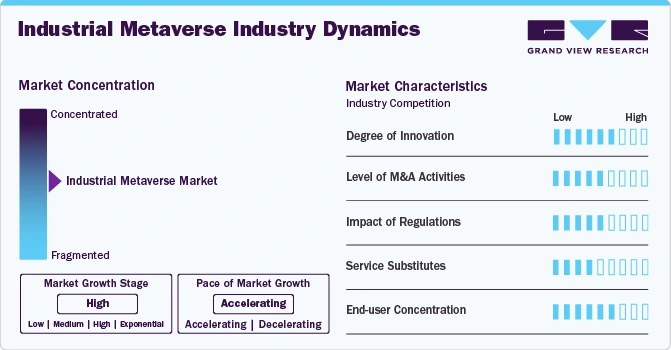
Credit: Grand View Research
The global spatial computing market is expected to reach USD 469 million by 2030. According to Siemens and S7P Global Market Intelligence, 62% of companies increase investment in industrial metaverse technologies.
The US leads in investment in the industrial metaverse, with 38.4% of companies actively using these technologies and 35.1% in the testing phase.
A study by Deloitte confirms 92% of manufacturers are piloting more than 1 metaverse use case and expect between 12% and 14% boosts in throughput & quality.
Business Value Drivers
Productivity and Quality Gains
GenAI copilots embedded in industrial design tools reduce programming efforts. For instance, Deloitte finds executives expect 14% improvements in sales, throughput, and first-time quality as metaverse pilots scale.
Accelerates Time-to-Market for New Products
By simulating entire factories and production flows in advance, companies finalize layouts, test scenarios, and identify bottlenecks before physical construction begins. BMW utilizes NVIDIA Omniverse to simulate its Neue Klasse production lines and reduce planning time by 30% before laying a single brick.
Enables Scalable, Safe, and Faster Workforce Training
Immersive simulations reduce onboarding time and increase retention by allowing people to learn complex procedures without physical risk.
Apple Vision Pro is being used by energy, aviation, and construction firms for interactive in-situ training. Deloitte reports that over 80% of manufacturers plan to use metaverse tools to achieve a 12% labor productivity gain.
Breakthroughs and Innovations
Funding Surges
- Cintoo raised 37 million to turn massive laser-scan files into lightweight meshes for as-built industrial metaverse twins.
- Hololight raised USD 12 million for heavy-CAD models to stream securely to head-mounted displays (HMDs) on shop floors.
Technology Breakthroughs
- NVIDIA Omniverse Cloud API: It streams photorealistic, RTX-rendered digital twins directly into their simulation and automation platforms. This integration enables real-time collaboration across different tools on high-fidelity industrial models and eliminates the need for file conversions and design iteration among globally distributed teams.
- TeamViewer Frontline Spatial: GE Aerospace leverages TeamViewer’s augmented reality-based 3D training platform to reduce global technician onboarding time while addressing global skills shortages.
Application Areas
Workforce Training & Onboarding
Spatial computing platforms are transforming employee onboarding and upskilling into interactive, high-fidelity experiences.
Hololight Hub enables heavy CAD models to be streamed to lightweight XR devices. It provides trainees access to life-size simulations without high-end hardware.
Logistics & Warehouse Digital Twins
By simulating material flow, robot movement, and operational layouts, logistics operators optimize systems before physical rollout.
Dematic’s AI Control Tower, revealed at NVIDIA GTC 2025, models AMR fleet behavior and facility layouts to streamline intralogistics ahead of deployment.
Cross-Enterprise Design Collaboration & Review
Photorealistic digital twins enable globally distributed teams to collaborate on complex product designs and system models in real time.
Spotlighting an Innovator: UNWARE
German-based startup UNWARE develops AI-driven tracking software that powers the UNWARE Holodeck, a portable cave automatic virtual environment (CAVE). It offers immersive virtual reality experiences without headsets or controllers.
The startup employs camera-based motion capture and deep learning algorithms to track full-body movements in real time. The software synchronizes user actions with the virtual environment.
Its intuitive gesture control supports collaborative, multi-user interactions without physical wearables. The Holodeck’s modular design and portability facilitate industrial design, defense training, real estate visualization, and retail engagement.

6. Clean Energy Expansion
The global shift toward sustainable energy is gaining momentum due to green hydrogen, fusion power, and solid-state batteries. These innovations are central to decarbonizing key sectors.
These are gaining popularity due to growing demands for safer, high-density storage in mobility, electronics, and grid systems.
Market Momentum
The green hydrogen market is set to grow to USD 199.22 billion by 2034, expanding at a CAGR of 41.46%, as industries adopt zero-emission fuel alternatives for transport and manufacturing.

Credit: Precedence Research
Fusion power, on the other hand, offers abundant, carbon-free baseload energy that could surpass USD 350 billion by 2050.
Meanwhile, solid-state batteries have market projections rising from USD 1.63 billion in 2025 to USD 19.14 billion by 2033 at an impressive 36.03% CAGR.
The Asia-Pacific region leads the green hydrogen market with a 47.22% share. The market is fueled by India’s National Green Hydrogen, which is targeting 5 million tonnes/year by 2030.
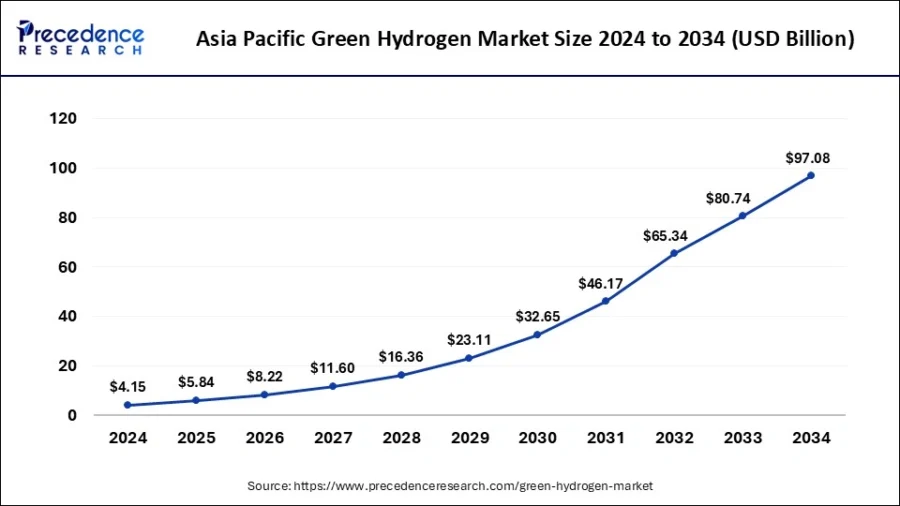
Credit: Precedence Research
France invested EUR 7.2 billion in public investment to develop a decarbonized hydrogen industry. Also, the US Department of Energy (DOE)’s Hydrogen Shot initiative targets USD 1/kg production costs by 2031.
The fusion energy sector is expected to exceed USD 350 billion by 2050 if technological milestones are achieved. Private fusion investment surpassed USD 7 billion by 2025, led by Commonwealth Fusion Systems (CFS).
Further, the UK’s STEP prototype targets grid-connected fusion by 2035.
Solid-state batteries are projected to make a major impact in the EV battery market, as supported by Toyota’s 1000 km-range prototypes and QuantumScape’s 15-minute charging cells.
Business Value Drivers
Green Hydrogen
Decarbonization
Green hydrogen offers a zero-emission substitute for fossil fuels in hard-to-abate industries like steelmaking and power generation. Sweden’s HYBRIT project cut CO2 emissions by at least 10% using hydrogen-based iron reduction, with SSAB targeting fossil-free steel production by 2030.
Balancing Renewable Supply with Hydrogen Storage
By converting surplus solar and wind energy into storable hydrogen, firms stabilize grid operations. Luxembourg’s Energy Dome facility stores 200 MWh of solar energy with 75 %+ round-trip efficiency.
Fusion Power
Abundant, Low-Carbon Baseload Energy
Fusion power promises a virtually inexhaustible source of clean electricity with negligible emissions.
Inherent Operational Safety
Fusion systems, unlike fission reactors, avoid meltdown risks and do not produce long-lived radioactive waste. General Fusion’s magnetized target fusion approach is an example of this safety profile.
Solid-State Batteries
High-Energy Storage for Advanced Mobility
Solid-state batteries generate twice the energy density of lithium-ion cells, which accelerates electric aviation and long-range EVs. NASA’s SABERS project reached 500 Wh/kg with a solid-state lithium-sulfur battery.
Improved Safety and Durability
With solid electrolytes replacing flammable liquids, these batteries drastically reduce the risks of thermal runaway, leaks, or combustion.
Affordable, Long-Duration Grid Storage
Form Energy’s iron-air solid-state batteries offer 100-hour storage at just USD 20/kWh. This approach provides a cost-effective solution to intermittency challenges in wind and solar integration.
Breakthroughs and Innovations
Funding Surges
Green Hydrogen: India approved an INR 19 744 crore national incentive plan to scale green hydrogen production.
Fusion Power: Over USD 7.1 billion invested in fusion energy, with government funding up 57% to USD 426 million in a single year.
Technology Breakthroughs
Green Hydrogen
- PEM Dominance: Proton Exchange Membrane (PEM) electrolyzers forecast a USD 2.4 billion market share.
- Manufacturing Expansion: Industrie De Nora began building Italy’s largest electrolyzer manufacturing facility, with demand already matching its annual output capacity.
Fusion Power
- Helion Energy received USD 425 million and announced plans to construct a 500 MW fusion plant in Everett, Washington. It targets operational readiness by 2030.
- High-Temperature Superconductors: Commonwealth Fusion Systems’ SPARC tokamak uses YBa₂Cu₃O₇ magnets to achieve 20 Tesla confinement and double conventional magnetic field strengths.
Solid-State Batteries
- NASA Advancements: NASA is engineering ultralight, high-density solid-state batteries for next-gen electric aircraft propulsion.
Application Areas
Green Hydrogen
Heavy Industries
Green hydrogen is being deployed in the transportation, aviation, shipping, and industrial sectors to replace fossil fuels and cut emissions.
Maersk’s methanol-powered vessels reduce absolute scope 1 and 2 GHG emissions by 96% by 2040. ZeroAvia’s ZA600 engines, which are powered by 600 kW hydrogen fuel cells and support 300 NM commercial flights in 10 to 20-seat aircraft by 2026.
In heavy industry, green hydrogen is increasingly used in steelmaking and chemical manufacturing to displace carbon-intensive processes.
Fusion Power
Industrial Heat & Materials Manufacturing
Heavy industries like steel, cement, and chemicals require temperatures that renewables can’t reliably deliver. Fusion’s high-grade heat (above 1000 degrees Celsius) could power direct electrification of kilns, forges, and reactors.
Solid-State Batteries
Consumer Electronics and Wearables
In smartphones, laptops, and wearables, solid-state batteries enable longer battery life, slimmer form factors, and greater safety due to their non-flammable solid electrolytes.
Companies like Samsung and Apple are exploring the integration of these batteries to power devices that support high-refresh displays, AI processing, and always-on connectivity without sacrificing battery endurance.
Spotlighting an Innovator: HYDGEN
HYDGEN is a Singaporean company that builds advanced green hydrogen electrolyzers. The startup utilizes proprietary catalysts, membranes, and stack designs to achieve high energy efficiency and cost-effectiveness.
It’s anion exchange membrane (AEM) technology operates without precious metals like iridium or platinum. The electrolyzers deliver hydrogen purity that is suitable for semiconductors, pharmaceuticals, and steel manufacturing.
With a modular design, the systems also offer operational flexibility and scalability, catering to small and mid-sized industries. HYDGEN’s on-site hydrogen generation further minimizes reliance on external supply chains and contributes to industrial decarbonization.
7. Synthetic Biology
Metabolomics therapeutics and synthetic biology are two separate but related fields.
Synthetic biology is the study of how to design and build new biological parts and systems. Metabolomics, on the other hand, looks at all the metabolites in a sample to learn more about how diseases work and how to make treatments that work better.
Together, these two fields are changing healthcare, agriculture, and manufacturing.
The synthetic biology market is expected to grow from USD 24.58 billion in 2025 to USD 192.95 billion by 2034, with a CAGR of 28.63%.
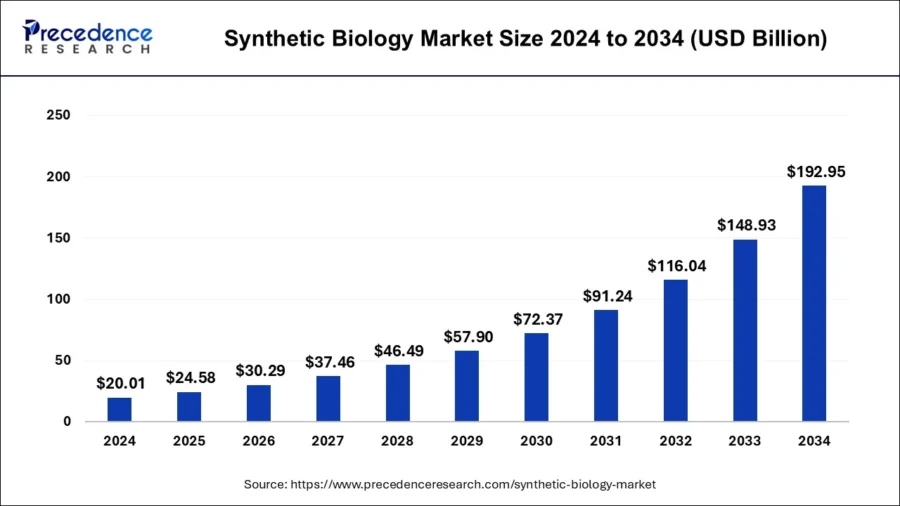
Credit: Precedence Research
At the same time, the metabolomics therapeutics market will grow from USD 3.64 billion to USD 11.32 billion over the same time, with a CAGR of 13.43%.
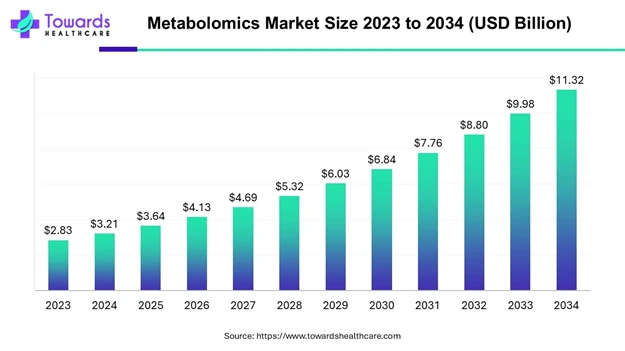
Credit: Biospace
Market Momentum
The synthetic biology market received USD 12.2 billion in venture capital funding in 2024. North America leads with a 39.6% market share, driven by initiatives like the Seattle Hub for Synthetic Biology. It secured USD 10 million this year to advance mammalian cell engineering and support startup formation.
The US market is expected to reach USD 41.26 billion by 2033. The EU’s bioeconomy strategy has mobilized EUR 4 billion for synthetic biology applications in green chemistry.
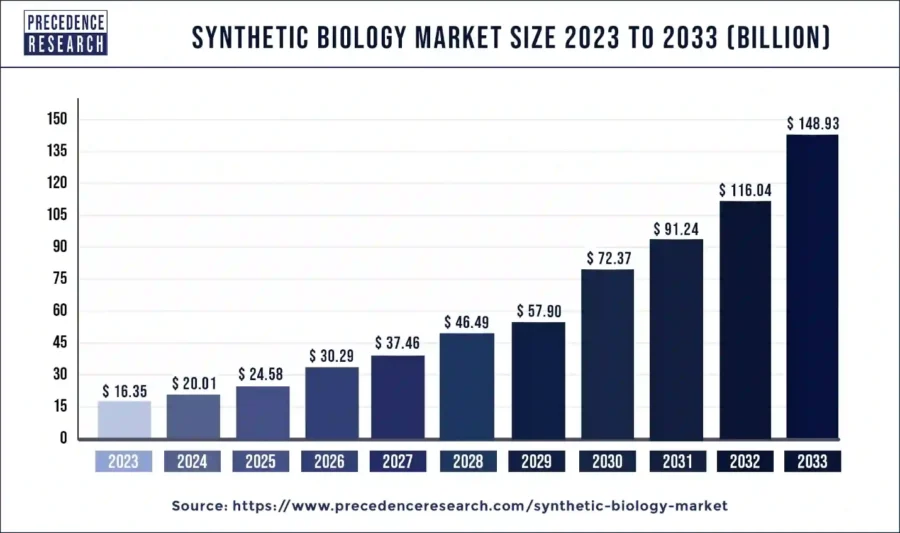
Credit: Precedence Research
The metabolomics services market is forecasted to reach USD 8.6 billion by 2034, driven by demand for cancer diagnostics and pharmaceutical R&D. North America leads this market as well, with Metabolon’s USD 60 million credit facility and NIH-backed initiatives.
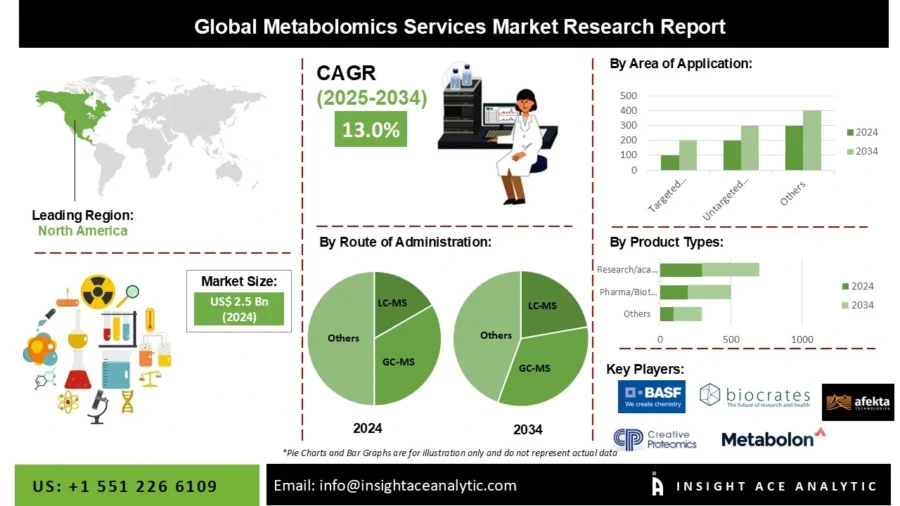
Credit: Insight Ace Analytic
Asia-Pacific is the fastest-growing region as India and China deploy NMR and mass spectrometry technologies for national-scale metabolic profiling and precision medicine efforts.
Business Value Drivers
Synthetic Biology
Bio-Manufacturing Revolution
Engineered microbial systems produce 60% of industrial enzymes and reduce chemical synthesis costs.
For example, Ginkgo Bioworks has accelerated production cycles by engineering yeast strains to synthesize flavor compounds. It reduced manufacturing timelines from 18 months to 6 months.
Improved Yield and Sustainability
Pivot Bio’s nitrogen-fixing microbes increase crop yields while significantly lowering synthetic fertilizer use. This positions synthetic biology as a sustainable solution to a USD 200 billion global fertilizer market.
Programmable Therapeutics
Synthetic biology powers CRISPR-based gene circuits for programmable cell therapies. Many clinical trials include synthetic biology components, especially for cancer immunotherapy, that show growing adoption in advanced medical pipelines.
Metabolomics Therapeutics
Personalized Medicine
By decoding individual metabolic profiles, metabolomics enables tailored treatment plans that reflect a patient’s unique biochemical state.
Bruker’s 15T NMR platforms identified numerous metabolites in cerebrospinal fluid from Alzheimer’s patients. The platform spotlights dysregulated purine pathways as new therapeutic targets.
Early and Accurate Disease Detection
Metabolomics improves diagnostic accuracy by identifying disease-specific metabolic biomarkers.
Breakthroughs and Innovations
Funding Surges
Synthetic Biology: Venture capital investment in synthetic biology reached USD 12.2 billion year-to-date. This increase is primarily driven by renewed interest in biofoundries, precision fermentation, and programmable therapeutics.
Metabolomics: Partnerships and investments are speeding up advances in metabolomics. For instance, Metabolon secured a USD 60 million credit facility to scale research, expand analytics capabilities, and grow its footprint in precision diagnostics and pharmaceutical R&D.
Technology Breakthroughs
Synthetic Biology
- SynTCE: Researchers developed the Synthetic Translational Coupling Element to enable complex synthetic pathways like artemisinin biosynthesis in E. coli.
- Rapid DNA and mRNA Synthesis: Twist Bioscience’s silicon-based gene printer achieves 1.6 million base pairs/day at USD 0.07 per base. This reduces turnaround times and costs.
Metabolomics Therapeutics
- Advanced Analytical Tools: The integration of high-resolution mass spectrometry with nuclear magnetic resonance spectroscopy has significantly expanded metabolite detection. It enables broader metabolic coverage in disease profiling.
Application Areas
Synthetic Biology
Agriculture
Pivot Bio develops microbial nitrogen fertilizers that enhance yields while reducing synthetic fertilizer use.
Indigo Ag improves biofertilizer effectiveness using metabolomics-guided microbial inoculants.
Food
In the food industry, Ginkgo Bioworks engineers yeast strains for custom production of flavors and fragrances that streamline fermentation-based manufacturing.
For industrial bioproduction, LanzaTech’s CO2-to-ethanol pathway is optimized with machine learning to achieve carbon conversion efficiency and scales to 100 million gallons/year.
Metabolomics Therapeutics
Diagnostics
In oncology, Metabolon partners with pharmaceutical companies to identify disease-specific metabolic biomarkers.
Drug Development
Metabolomics strengthens drug development pipelines. For instance, Moderna’s AI model was trained on numerous metabolic profiles to optimize mRNA vaccine stability and increase durability.
Hepatocyte-based metabolite screening also achieves 89% specificity in detecting drug-induced liver injury, saving clinical trial attrition costs.
Spotlighting an Innovator: Metastate Bio
Metastate Bio is a US-based company that develops an in-silico simulation and optimization platform for bioprocess engineering. It enables researchers to model and refine microbial systems such as E. coli, yeast, and CHO cells without extensive laboratory experimentation.
The platform integrates genome-scale metabolic modeling, flux balance analysis (FBA), and genetic algorithms to simulate the effects of environmental conditions and genetic configurations on cellular performance.
This assists companies in identifying metabolic bottlenecks, optimizing production conditions, and minimizing byproducts. This way, Metastate Bio streamlines bioprocesses and provides a customizable toolbox for in-silico experiments.
8. Humanoid & Collaborative Robots
Humanoids replicate human motion and cognition to handle tasks ranging from assembly line support to patient care. Meanwhile, collaborative robots are enabling agile workflows in factories, hospitals, retail, and education.
Market Momentum
The global humanoid robot market is projected to rise from USD 2.92 billion in 2025 to USD 15.26 billion by 2030 with a CAGR of 39.2%.
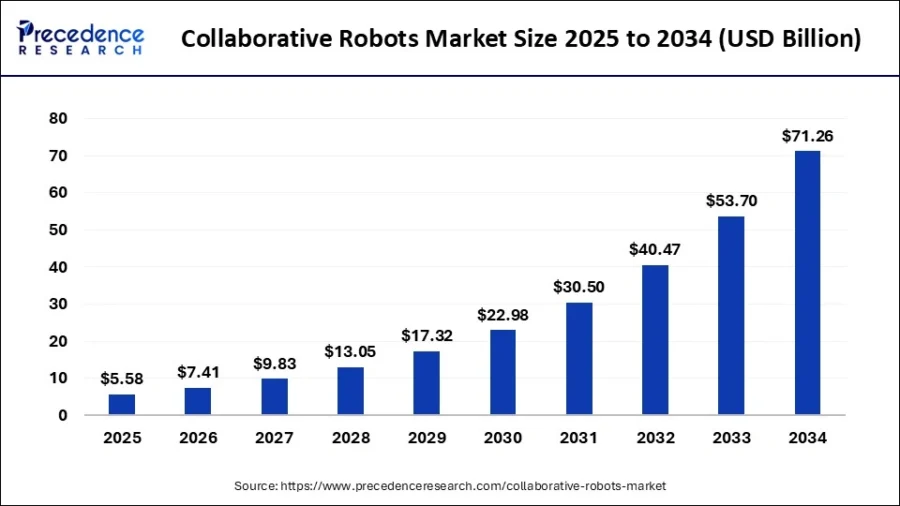
Credit: Precedence Research
Simultaneously, the cobot market is set to expand from USD 5.58 billion to USD 71.26 billion by 2034, growing at a 32.7% CAGR.
The US humanoid robot market is set to grow to USD 3.83 billion by 2029, at a CAGR of 45.7%, driven by investments from OpenAI, NVIDIA, and Microsoft.
In healthcare, cobots improve rehabilitation and assistive care, while the construction industry reduces worksite injuries and accelerates project timelines with cobots. Europe is the global leader in cobot adoption.
Business Value Drivers
Labor Shortage Mitigation
Humanoid robots and cobots directly address global labor shortages by automating repetitive and physically strenuous tasks. Cobots are expected to fill critical gaps, with over 64 000 deployed per year in North America by 2030.
Cost Efficiency and Rapid ROI
Cobots reduce production costs in sectors like automotive assembly. For instance, the payback period for the UR10 robot installed at Orkla is just 195 days.
AI-Driven Operational Optimization
Machine learning enhances cobot performance by dynamically allocating tasks based on real-time production needs. This intelligent coordination improves assembly line throughput and supports agile manufacturing and scalable operations.
Breakthroughs and Innovations
Funding Surges
Humanoid Robots: Robotics-focused startups secured investments of approximately USD 9.7 billion in 7 months, with a large share directed toward humanoid systems. For instance, Ray Kurzweil’s humanoid robot startup is in talks for a USD 100 million investment.
Physical Intelligence raised USD 400 million at a USD 2 billion valuation to accelerate the development of general-purpose humanoid robots.
Collaborative Robotics: Collaborative Robotics. closed a USD 100 million Series B round to scale cobots.
Technology Breakthroughs
Humanoid Robots:
- Tesla Optimus Gen 2: Demonstrated a 20 kg payload capacity and 5-hour operational runtime.
- Boston Dynamics’ Atlas: Transitioned to a fully electric system with 360-degree joint rotation. It enables complex manipulation tasks tailored to construction environments.
- Berkeley Humanoid Lite: Introduced a fully open-source design that uses 3D-printed cycloidal gears to reduce hardware costs and can be assembled under USD 5000.
Collaborative Robotics
- Universal Robots’ PolyScope X: Released a no-code interface that simplifies cobot programming and reduces deployment timelines.
- NVIDIA’s Project GR00T: Developed a generative AI foundation model that enables humanoids and cobots to learn new tasks from a single demonstration.
Application Areas
Manufacturing
Agility Robotics’ Digit is deployed in Amazon warehouses to retrieve and carry bins. This reduced item retrieval time by 25% through advanced bipedal mobility.
Healthcare
Cobots in healthcare support medication dispensing and improve both care delivery and staff efficiency. For instance, Mentee Robotics’ Stevie robot assists elderly patients with companionship and fall detection while reducing caregiver workload.
Retail and Hospitality
Humanoid and cobot systems elevate customer interactions in service environments. SoftBank’s Pepper is deployed in many retail stores for personalized recommendations. It increased sales conversions by 13% in revenue and a 6-fold increase in sales.
Spotlighting an Innovator: Robots For Humanity
Robots For Humanity is an Argentine company that offers AI-driven humanoid robotics integrated with digital twin technology to automate high-risk and physically demanding tasks.
The startup’s robots undergo training and optimization within hyper-realistic virtual simulations powered by platforms like NVIDIA Omniverse. This enables precise task execution before real-world deployment.
Consequently, this approach enhances safety, reduces operational costs, and liberates human workers from hazardous and repetitive duties.
9. Cyber-Resilient Data-Centric Security
Cyber-resilient, data-centric security frameworks protect the data regardless of where it resides or how secure the surrounding infrastructure may be. It embeds encryption, access controls, and policy enforcement directly into data assets to ensure continuous protection across cloud, edge, and on-premise environments.
Data-centric models offer resilience against ransomware, AI-generated phishing campaigns, and expanding hybrid architectures. They align with zero-trust principles and support regulatory compliance for handling sensitive personal, financial, and operational data.
Market Momentum
The global data-centric security market is projected to grow at a CAGR of 24.2%, reaching USD 24.01 billion by 2030.
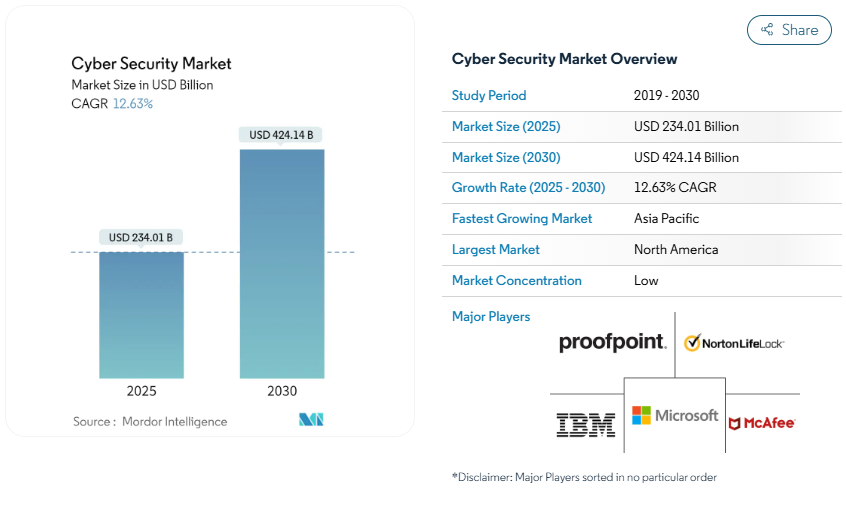
Credit: Mordor Intelligence
In parallel, the broader cybersecurity market will expand to USD 424.14 billion by 2030.
North America holds a 40% market share as of 2024 due to the strict enforcement of CCPA and HIPAA.
The data-centric security market is set to grow at a CAGR of 21.4% through 2030.
Europe is witnessing an increase in compliance-driven security spending, with GDPR fines totaling EUR 1.2 billion in 2024.
SAP’s Data Custodian platform reported GDPR compliance adherence across EU enterprises. This reflects increased adoption of data masking and classification tools.
Business Value Drivers
Enhanced Data Protection at the Core
Focusing security controls directly on the data ensures that sensitive assets remain encrypted and access-controlled, even if networks are compromised.
This strategy reduces breach risks and safeguards intellectual property. LevelBlue highlights this strategy as a critical defense pillar for modern enterprises.
Zero Trust Integration for Granular Control
Data-centric security aligns seamlessly with zero trust principles that leverage continuous authentication, least-privilege access, and microsegmentation.
For example, Palo Alto Networks’ Prisma Cloud applies data classification tags to SaaS transactions that cut lateral movement risks and strengthen end-to-end visibility.
Cost Optimization via Exposure Reduction
Organizations deploying data-centric security report a USD 4.88 million reduction in breach remediation costs. This cost efficiency stems from minimized data exposure and faster incident containment.
Breakthroughs and Innovations
Funding Surges
- Venture Capital Growth: Cybersecurity startups raised USD 2.7 billion in Q1 2025. This marks a 29% quarter-over-quarter increase. Data-centric security platforms such as Torus secured USD 67 million in venture financing to advance secure data collaboration tools.
- Israeli Cyber Surge: Israeli cybersecurity firms attracted USD 4 billion in funding.
Technology Breakthroughs
- Seclore was named “Data Security Solution of the Year” in 2024 for its innovative approach that embeds protection within the data itself, rather than relying on securing the surrounding infrastructure.
- Trend Micro released an AI-powered security suite that autonomously predicts, identifies, and neutralizes threats.
Application Areas
Government
Governments are adopting post-quantum cryptography and zero-trust frameworks to protect classified datasets and mission-critical systems. NIST-approved CRYSTALS-Kyber algorithms provide resilience against future quantum decryption threats.
Smart Cities
Barcelona invested USD 150 million in a resilient city initiative that secures traffic, water, and energy systems by encrypting IoT data lakes. This smart infrastructure ensures both service continuity and real-time anomaly detection in distributed sensor networks.
Spotlighting an Innovator: Praeryx
Praeryx is a Japanese company that offers a cyber threat intelligence solution. Its proprietary agentic intelligence, Fabric, integrates artificial intelligence and customized large language models (LLMs) to analyze and provide contextualized and timely threat insights.
This system deciphers complex cyber threats by eliminating legacy biases and offering localized intelligence in diverse geographies. Additionally, Praeryx’s Cyber Risk Quantification framework translates abstract cyber risks into measurable metrics. This enables enterprises to anticipate threats and strengthen cyber defenses
10. Space-Based Manufacturing & Energy
Space-based manufacturing and energy leverage microgravity, vacuum purity, and continuous solar exposure to redefine industrial processes.
Microgravity enables the fabrication of ultra-pure materials, like optical fibers and semiconductors, while space-based solar power (SBSP) offers a resilient energy supply unconstrained by weather or day-night cycles.
The convergence of these technologies is driving innovation across pharmaceuticals, advanced electronics, and clean energy infrastructure.
Market Momentum
The in-space manufacturing market size is expected to reach 22.47% CAGR through 2030. Japan deployed gallium arsenide (GaAs) solar cells that demonstrated 32% energy conversion efficiency in prototype satellites this year.
Business Value Drivers
Material Science Revolution
Semiconductor wafers are manufactured in orbit with precision using microgravity casting. Such precision is critical for scaling photonic computing and quantum devices, where surface integrity and alignment are paramount.
Breakthroughs in Optical Fiber Technology
Flawless Photonics has demonstrated that ZBLAN optical fibers fabricated in space deliver signal losses as low as 0.001 dB/km. This advancement could transform global communications by enabling ultra-low-latency, high-bandwidth networks.
Cost-Effective Lunar Industrialization
Innovations in lunar infrastructure dramatically lower space exploration costs. Lunar-sourced liquid oxygen (LOX), for instance, lowers the cost and launch burden of Mars missions through in-situ resource utilization (ISRU). Meanwhile, KUKA’s MMIC-I robotic swarms autonomously build modular lunar bases that reduce construction costs.
Breakthroughs and Innovations
Funding Surges
Private Sector Momentum: 5 companies focused on space infrastructure and defense technologies collectively raised USD 513 million.
Eascra Biotech has been awarded a US National Science Foundation Small Business Innovation Research grant. The grant is valued at USD 274 million to fund targeted microgravity drug production and next-gen GaN-based high-voltage power systems.
Technology Breakthroughs
- Eascra Biotech leverages microgravity to enhance targeted drug delivery via Janus Base Nanoparticles (JBNs). This will improve treatments for cancer and osteoarthritis.
- Space Solar, backed by over GBP 10 million in government funding, is developing orbital solar power stations assembled by autonomous robots. The planned prototype will transmit energy to Earth using radio waves, which will be generated by large-scale solar arrays assembled by robots.
Application Areas
Semiconductor Production
Microgravity is now being explored as a platform for precision semiconductor fabrication. Sierra Space collaborated with Astral Materials and Space Forge to develop orbital chip manufacturing systems. It utilizes gravity-free conditions for improved crystal quality and defect reduction.
Renewable Energy: Space-Based Solar Power and Orbital Sustainability
Space Solar’s orbital energy platforms deliver continuous, clean power to Earth. With robotic assembly of large-scale solar arrays in orbit, this initiative supports global decarbonization.
Spotlighting an Innovator: AndroMach
AndroMach is a French company that provides reusable spaceplanes for suborbital and orbital missions. Its suborbital vehicle, ENVOL, employs turbojet engines for atmospheric flight and a pressure-fed LOX/biopropane rocket engine for space ascent.
The orbital shuttle, ETOILE, launches atop small partner rockets that support missions lasting from days to months. This way, AndroMach makes microgravity applications more accessible and advances space-based industrial capabilities.
Explore Disruptive Future Technology Trends & Solutions
With thousands of emerging technologies and startups, navigating the right investment and partnership opportunities that bring returns quickly is challenging.
With access to over 7 million emerging companies and 20K+ technologies & trends globally, our AI and Big Data-powered Discovery Platform equips you with the actionable insights you need to stay ahead of the curve in your market.
Leverage this powerful tool to spot the next big thing before it goes mainstream. Stay relevant, resilient, and ready for what is next.

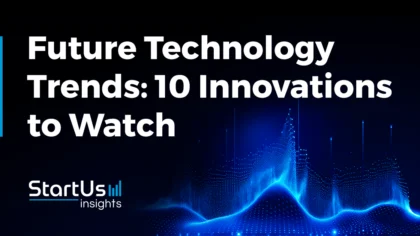


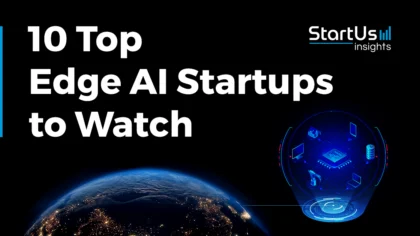
![10+ Top Deep Tech Trends [2025-2030]: From Key Statistics to Strategic Enterprise Payoffs](https://www.startus-insights.com/wp-content/uploads/2025/05/Deep-Tech-Trends-SharedImg-StartUs-Insights-noresize-420x236.webp)




